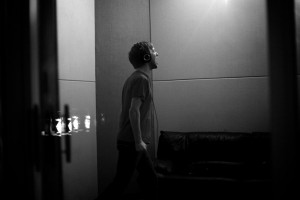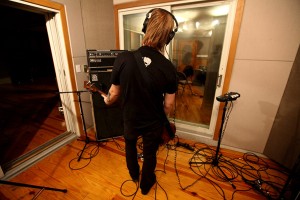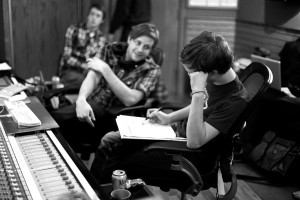No Artificial Reverb Allowed! The Tracking and Mixing Challenge of La Dispute’s “Wildlife”
HARLEM, MANHATTAN: You don’t have to imagine what’s like to be in the head of La Dispute. Everything about this intensely emotional rock band – their lyrics, their message, their music, and even the way it’s recorded – is about removing the mystery.
It’s all obvious from the moment that you hear the band’s singer, Jordan Dreyer, pushing it out in “a Departure,” the opening track from their arresting new album Wildlife. Don’t wait around for the raw energy of this Michigan five-piece to let up either, because the artfully charging guitars, rhythmic explorations, and intimate space of their post-hardcore screamo/progressive rock songs just keep on coming at you.
The recording team of producer Andrew Everding (Thursday) and engineer Joe Pedulla (Swizz Beatz, Thurday, Patent Pending) arrived at an early self-imposed challenge while working with this uniquely inspired group: no artificial reverb allowed. Whether it was plates or Lexicon PCMs, all ambience not imposed by the band’s actual surroundings was banished on Wildlife – instead, only the natural sound of the rooms at NYC’s Stadium Red and Chicago’s Drasik Studios were allowed to influence the sonic sense of space.
Like many feats of engineering, the “no reverb” rule came not by design but as a matter of natural course, starting at the initial sessions in Chicago. “We had miked the drums in the live room, and the room mics that were in there were set up for talkback,” Pedulla recalls. “Then the guitarist was in there to be next to his amp, and we started realizing, ‘This sounds cool.’ The parts needed this ambience, and sounded really good with that sound that you don’t get from close mics.
“So we started printing more and more room mics,” Pedulla continues, “and we realized early on the importance of that way of working. Collectively, we started printing everything by having a ribbon mic in the center of the room. Midway through the record, we made it official: Shoot for no digital reverb, and bash away in a way that you can’t do in a basement studio. Obviously, it’s a digital album to begin with, recorded entirely into Pro Tools, so we did what we could from there to remain in the natural era of recording. It was a fun science experiment for us to do.”
AMPED UP WITHOUT REVERB
After recording six of Wildlife’s 14 songs in Chicago (without vocals), the scene shifted to NYC, where the rest of the album was tracked in the spacious complex of Stadium Red uptown. As Everding, Pedulla, and La Dispute — Dreyer, drummer Brad Vanger Lugt, guitarists Chad Sterenburg and Kevin Whittemore, and bassist Adam Vass – progressed, they got an increasing feel for the appeal of the real reverb that they were cultivating.
“We were just trying to capture what it would be like for an audience member sitting and listening to a guitar in a room,” says Pedulla. “There was something natural about it — no one ever listens to a guitar with their ear right against the speaker. Whenever someone is in their bedroom or basement playing guitar there’s a natural ambience to it, so we wanted to put that down and get the big parts to sound really big, and really ambient.
“The singer, Jordan Dreyer, has this crazy dynamic range – a 20dB swing from how loud and quiet he gets. So there are some vocal parts with no resonance at all, where he’s speaking/singing softly, the room is not echoing, and he sounds close and in-your-face. Then the dynamic swing happens, and we would see how big it can get.”
SPATIAL RELATIONS
At Stadium Red, where Pedulla frequently works, the team took full advantage of the versatile, 1,000 sq. ft. Studio A. “I love that room for its flexibility,” Pedulla says. “It’s got gobos and a throw rug to emulate the size of different rooms, and with the small (300 sq. ft.) drum room, leaving the door full or partially open makes a difference. You can really have everything sound intimate with close mics, or you can open your room mics and get the long throw on it.”
To record the drums at Stadium Red, Pedulla first put a combination of close mics and boundary mics on the kit. Leaving the drum room’s sliding door open, he then miked the large live room purely to pick up the drums’ resonance. “We did a couple of different setups,” says the engineer. “We had a Royer 121 as our mono room mic, and a pair of AKG 414’s as the stereo-pair room mics, or two of the Audio Technica3060 tube condenser mics, which they don’t make anymore.
“There was another mono room mic from the ‘50’s or ‘60’s, the STC 4021 that I know as a ‘ball and basket.’ It’s a really cool, dark-sounding ribbon mic. Ribbon mics on rooms are king, and that’s what we used for our vocal room mic as well — there’s something about the way a ribbon mic chops off the top end, and makes it kind of smooth. Using a ribbon for the room on drums you don’t get too much of a cymbal bang, it’s not harsh, with a really solid top end and it gives you the mid range you need to capture that natural, resonating snare reverb.”
Dreyer’s close vocal mic was the Bock Audio 151 tube microphone, going into an Amek 9098 preamp, then tamed by an Empirical Labs Distressor. “We printed room mics on the vocals as well the whole album through, except for one song because of scheduling we had to record in Stadium Red’s C room,” Pedulla notes. “So for that, while I was mixing I took a Genelec 1031 speaker and placed it in the vocal booth in the exact spot that Jordan was standing. Then I placed the STC 4012 ribbon mic in the center of the live room and ‘reamped’ the vocals.”
When miking guitars, Pedulla looked to a Shure SM57 and a Royer 121 for close mikes, and a Neumann TLM 103 for the room. “There’s something cool about that, from 6’ to 25’ back from the amp. You can put it right in front of the amp and still get the ambience, or put it all the way at the end and really have it sounding big.”
Those listening even semi-carefully will hear some artificial wash on the guitar part for the song “a Poem.” “We used an analog spring reverb, the Sound Workshop 262 Stereo Spring Reverb, on one guitar part there on input,” concedes Pedulla. “The guitarist, Chad insisted on using it — he used it sort of as you would a pedal into his guitar amp. We were using it as an effect, by picking up and actually dropping the 2U box. Rest assured, this was accompanied by a room mic for more reverb.”
StadiumRed’s SSL G+also helped shape and tame the sound. “We had a 26” kick drum, and that went straight into the SSL,” Pedulla says. “Those drums were so big, and there was something about the kick that I hated at first, but Andrew and I reduced 15 dB at 120Hz – that solved the problem of the kick drum, getting rid of the low-mid garbage we didn’t need. The flexibility of that EQ and that one cut alone saved the drum kit – to me, cutting is just as important as boosting, if not more.”
MAKING IT WORK IN THE MIX
Knowing that Studio A and the SSL G+ were booked up, Pedulla executed the Wildlife mix in the box. “I really liked using HEAT in Pro Tools|HD on this album,” he notes. “For a raw-sounding rock band like La Dispute are, I really liked overcompressing at times and then hearing the harmonic character of the HEAT distortion. I summed through the SSL, with two faders up to unity gain – the SSL 2-buss compressor combined with HEAT was really important to the glue of the mix.”
While temptation ran rampant, Pedulla was able to keep his hands off any and all reverb – hardware or plugins. “It was always in the back of my mind, but I was on this mission to make the record happen without it,” states Pedulla. “Even if it was sounding weird, and the room mic wasn’t able to give me what I wanted to throw in the mix, I just did what I could to make it work. We agreed on it, that’s what it is, and we accepted that fact. Even if it was a little bizarre or not quite perfect, that’s what it was going to be, regardless of the character.”
BEAR-HUGGING THE LIMITATIONS
For Pedulla, Everding, and the brave souls of La Dispute, the self-imposed restrictions of Wildlife were well worth the pain. “You kind of get painted into a corner sometimes, and you need to know how to dig yourself out,” Pedulla says. “The limitations are fun. It’s the challenge of engineering. Some days you’ll say, ‘I have to focus on compression and making this sit well,’ realizing the dynamic and importance of it for the band.
“One of the big lessons I learned from this project is the importance of room mics, and that I shouldn’t neglect them when recording. Even if the fader is at -25 dB, there’s still a little ambience in there, so it can sit in the mix a bit better. And now I know there are some things you can do with room mics that you can’t do with digital reverb — that’s for damn sure!”
— David Weiss
Wildlife is available now on No Sleep Records. Stream the album and purchase at http://www.ladisputemusic.com.
Please note: When you buy products through links on this page, we may earn an affiliate commission.










